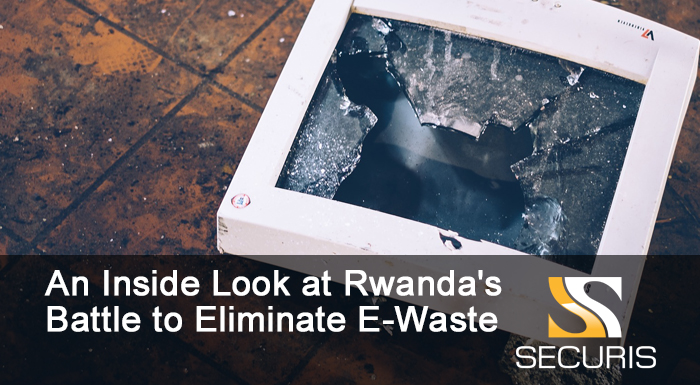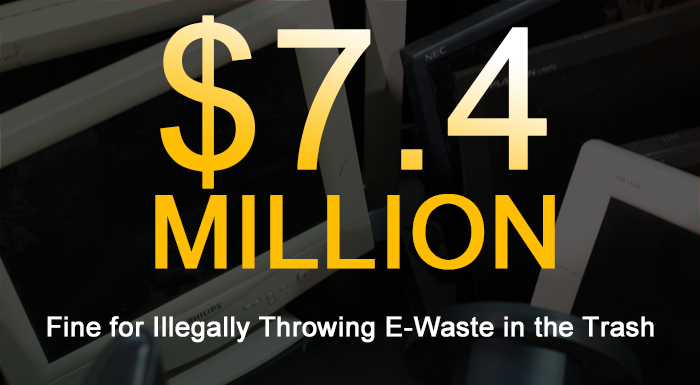Along with the inexorable march of technology, and the creation and consumption of new electronic devices, the world is dealing with the ever-growing problem of e-waste. While some countries are making efforts to properly recycle or reuse electronic equipment and devices, other countries are still struggling with finding a means, and in the meantime are simply storing e-waste in landfills or warehouses. It’s a growing problem that will require a continual effort if we are going to ever get it under control.
The world of e-waste has been growing. China recently claimed the top spot in producing the most e-waste, with the USA in close second.
But in the country of Rwanda, change is happening in the fight to tackle e-waste. While the country’s e-waste production has continued to grow, generating around 10,000 tons a year, a company there is working to make sure it’s ready to take it all on. Introducing EnviroServe Rwanda, the country’s only e-waste recycling plant operator, and it only has one e-waste recycling plant to operate. For now.
E-Waste Recycling: A Recipe for Economic Growth?
Currently, the EnviroServe Rwanda recycling plant has been able to collect 700 tons of e-waste. But plans are already in place to expand operations and open a second facility. This is part of an effort to increase e-waste responsibility as well as nurturing a circulating economy. One way that the company is trying to grow their efforts is by opening more collection centers for e-waste. Currently, they only have three. But their plan is to have at least 30 across the country, making widespread e-waste management more manageable.
The other way this effort for growth works is by how EnviroServe Rwanda operates by handling e-waste in several ways: recycling, reusing, and repurposing.
Whatever can be refurbished, is renovated and repurposed. Computers are repaired and sold to schools. Other office equipment is also repaired and sold to schools. This provides equipment for education facilities, while also providing electronics with a second life, reducing the new for more and reducing the potential for new e-waste. E-waste that can be recycled is dismantled and recycled to remove both the hazardous waste associated with e-waste and to recover valuable components and materials. Some materials that they can recover from e-waste are those such as aluminum, copper, plastic, and steel.
Such efforts can turn the burden of e-waste into an economic opportunity, and one that promises growth. Profit can be made by recovering valuable materials and selling them back to appropriate industries. Steel can be sold to be a steel company to then be repurposed as building materials. Plastics can be sold to manufacturers to produce more textiles and other products. Aluminum can be sold to companies that manufacture cans or even parts for air transportation. And in the end, everyone profits from this effort to reduce e-waste.
Replicating these efforts in other nations can boost their economies as well, while reducing health risks for their people and reducing damage to the environment by dumping e-waste in landfills.
Challenges to the E-Waste Economy
While more countries are making efforts to control e-waste, and many are recognizing the economic opportunities to be found in e-waste management, there are still challenges that continue to stand in the way. For some countries, it is harder than others, but the challenges still stand.
In 2017, the 16th International Electronics Recycling Congress (IERC 2017) in Salzburg, Austria, came together to address the e-waste situation and the recycling efforts. It was recognized that there were still challenges that stood in the way of e-waste management becoming a true economically-promising industry.
Mainly, the problem rested with the continual progression of technology. As technology progress and the miniaturization of devices continues, devices and their materials are decreasing in value. This, in turn, places stress on the financial viability of the costs to recycle e-waste versus the profit gained from selling recovered materials and refurbished equipment. It is predicted to be a continual battle. Recycling facilities and companies will have to make strong efforts to increase the economical and operational efficiency of their facilities and recycling methods in order to keep up with the ever-reducing costs and value of equipment and materials.
Another challenge to the e-waste management effort is how to handle the transportation of e-waste across borders with other countries. There are a lot of factors that will determine whether it’s economical to transport e-waste to other countries, and what can be done to move things “towards promoting the circular economy”.
Takeaway
While nations are slowly making the right decision to establish regulations and laws for managing e-waste properly, the best thing to do about getting things moving along faster is by taking action. You can search for local organizations that properly dispose of e-waste.
In the USA, not all states have laws or regulations regarding e-waste yet, but that doesn’t mean there aren’t any organizations or centers that might support the proper disposal and recycling of e-waste. The problem of e-waste is not going to shrink any time soon. It’s likely to keep growing for quite some time before we finally rein it in.
If you need help with making sure that your electronics recycling is kept in compliance with e-waste regulations and all relevant laws, don’t hesitate to contact us. Securis has been providing excellence since 2003 and can help make sure you remain compliant. We also have lots of great information regarding IT asset disposal solutions.

